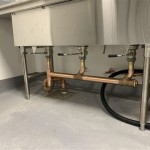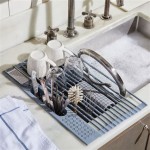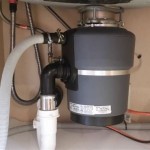How To Clean Smelly Sink Drains
A smelly sink drain is a common household problem that can be both unpleasant and a potential indicator of underlying issues. The odors emanating from the drain are typically caused by a buildup of food particles, grease, hair, and other organic matter within the drainpipe. This accumulated debris decomposes, creating foul-smelling gases like hydrogen sulfide, which are then released into the surrounding environment. Regular cleaning and preventative maintenance are essential to eliminate these smells and maintain a sanitary kitchen or bathroom.
Addressing a smelly sink drain requires a systematic approach. Identifying the cause of the odor and selecting the appropriate cleaning method are crucial steps. While commercial drain cleaners offer a quick solution, they often contain harsh chemicals that can damage pipes and pose environmental risks. Natural and DIY cleaning methods are often equally effective, safer for the environment, and less likely to corrode plumbing systems. This article provides a comprehensive guide to cleaning smelly sink drains, outlining various methods and preventative strategies.
Identifying the Source of the Odor
Before attempting to clean a smelly sink drain, it is important to determine the likely source of the odor. Different types of smells can indicate different problems. For example, a rotten egg smell is often indicative of hydrogen sulfide gas produced by decaying organic matter. A musty or moldy smell could suggest the presence of mold or mildew growth within the drainpipe or P-trap.
Examine the drain area for any visible signs of debris, such as food particles or hair. Check the drain stopper for buildup and remove any visible obstructions. If the smell is particularly strong, it may indicate a more significant clog deeper within the drainpipe. In some cases, the smell may originate from the garbage disposal unit, if one is installed.
Pay attention to when the smell is most noticeable. Does it worsen after running the water, or does it persist even when the sink is not in use? This information can help pinpoint the location of the source. If the smell is present in multiple drains, it may indicate a problem with the main sewer line, requiring professional attention.
Effective Cleaning Methods
Several methods can be employed to clean smelly sink drains effectively. These methods range from simple DIY solutions to more intensive cleaning procedures.
Hot Water Flush: Start with the simplest solution: flushing the drain with hot water. Pour a kettle or pot of boiling water down the drain. The hot water can help to dissolve grease and loosen accumulated debris, allowing it to be flushed away. This method is particularly effective for minor clogs and preventing future buildup. Ensure the drain is not porcelain, as boiling water can damage it. Use very hot tap water in this case.
Baking Soda and Vinegar: This classic combination is a natural and effective drain cleaner. Pour about one cup of baking soda followed by one cup of vinegar down the drain. The mixture will fizz and bubble, helping to loosen debris and neutralize odors. Let the mixture sit for about 30 minutes, then flush with hot water. This method can be repeated several times for stubborn odors.
Baking Soda, Salt, and Boiling Water: A variation on the baking soda method involves using salt in addition to baking soda. Pour 1/2 cup of baking soda and 1/2 cup of salt down the drain, followed by a kettle of boiling water. Let the mixture sit overnight and then flush with hot water in the morning. The salt acts as an abrasive, helping to scrub the drainpipe clean.
Dish Soap and Hot Water: For grease buildup, dish soap can be an effective cleaning agent. Pour a generous amount of dish soap down the drain, followed by hot water. The dish soap helps to emulsify the grease, allowing it to be flushed away. This method is especially useful for kitchen sink drains that are prone to grease accumulation.
Plunger: A plunger can be used to dislodge clogs and force debris out of the drainpipe. Ensure there is enough water in the sink to cover the cup of the plunger. Create a tight seal around the drain opening and plunge vigorously for several minutes. This method is effective for removing physical obstructions in the drain.
Drain Snake or Auger: A drain snake or auger is a flexible tool that can be inserted into the drainpipe to break up and remove clogs. Insert the snake into the drain opening and rotate it to break up any obstructions. Carefully pull the snake out of the drain, removing any debris that is attached to it. This method is effective for removing hair, grease, and other stubborn clogs.
Enzyme Drain Cleaners: Enzyme drain cleaners contain natural enzymes that break down organic matter. These cleaners are a gentler alternative to chemical drain cleaners and are safe for use in all types of pipes. Follow the instructions on the product label for proper application. Enzyme drain cleaners are particularly effective for preventing future buildup and maintaining a healthy drain system.
Preventative Measures
Preventing smelly sink drains is often easier than treating them. Implementing a few simple preventative measures can help to minimize buildup and keep drains smelling fresh.
Strainers: Use strainers in all sink drains to catch food particles, hair, and other debris before they enter the drainpipe. Clean the strainers regularly to prevent them from becoming clogged.
Avoid Pouring Grease Down the Drain: Grease hardens as it cools, causing clogs in the drainpipe. Dispose of grease in a separate container and avoid pouring it down the drain. Wipe greasy pans with paper towels before washing them to remove excess grease.
Flush with Hot Water Regularly: Run hot water down the drain for a few minutes after each use to flush away any remaining debris. This helps to prevent buildup and keep the drainpipe clean.
Baking Soda Flush: Periodically flush the drain with baking soda and hot water to prevent odors from developing. Pour 1/2 cup of baking soda down the drain, followed by hot water. Let the mixture sit for a few minutes and then flush with more hot water.
Monthly Deep Clean: Perform a deep clean of the drainpipe on a monthly basis using baking soda and vinegar or another effective cleaning method. This helps to remove any accumulated debris and prevent odors from developing.
Garbage Disposal Maintenance: If the sink has a garbage disposal, run cold water while operating the disposal to help flush debris down the drain. Avoid putting large amounts of food waste or fibrous materials into the disposal. Periodically clean the garbage disposal by grinding ice cubes and lemon or lime rinds to freshen and clean the blades.
Check the P-trap: The P-trap is a U-shaped pipe located under the sink that traps water to prevent sewer gases from entering the home. Make sure the P-trap is properly installed and that it contains water. If the P-trap is dry, run water down the drain to refill it.
By following these preventative measures, homeowners can significantly reduce the risk of smelly sink drains and maintain a clean and sanitary plumbing system. Regular maintenance and prompt attention to any signs of buildup or odor are essential for preventing more serious drain problems.
In addition to the methods described above, there are several other considerations that can contribute to maintaining a healthy and odor-free drain system. Understanding the types of materials that should never be disposed of down the drain, as well as recognizing the signs of more serious plumbing issues, are crucial aspects of preventative maintenance.
Certain materials should never be disposed of down the drain, as they can cause significant clogs and damage the plumbing system. These include coffee grounds, which can accumulate and solidify in the drainpipe, oil-based paints, which can harden and restrict water flow, and medications, which can contaminate the water supply. Additionally, feminine hygiene products and other non-biodegradable items should always be disposed of properly in the trash.
Recognizing the signs of more serious plumbing issues is also important for preventing costly repairs. Slow draining, gurgling sounds coming from the drain, and water backing up into the sink are all potential indicators of a more significant clog or a problem with the main sewer line. If these symptoms are present, it is advisable to consult a professional plumber to diagnose and resolve the issue.
Furthermore, the type of pipes used in the plumbing system can also affect the likelihood of developing clogs and odors. Older pipes made of cast iron are more prone to corrosion and buildup than newer pipes made of PVC or PEX. If the plumbing system is old or in poor condition, it may be necessary to replace the pipes to prevent recurring drain problems. A plumber can assess the condition of the pipes and recommend the appropriate course of action.
Finally, maintaining a consistent cleaning schedule and being mindful of the materials that are disposed of down the drain are the most effective ways to prevent smelly sink drains and maintain a healthy plumbing system. By following the guidelines and methods outlined in this article, homeowners can keep their drains clean, odor-free, and functioning properly for years to come. A proactive approach to drain maintenance not only eliminates unpleasant odors but also helps to prevent more serious plumbing problems that can be costly and inconvenient to resolve.

How To Clean A Stinky Sink Drain

How To Clean A Smelly Drain Easy Diy Fixes For Foul Odors

How To Clean A Smelly Drain Bond Cleaning In Melbourne

How To Clean A Smelly Drain Easy Diy Fixes For Foul Odors

How To Clean Smelly Drains Ultimate Guide Fresh Sinks

How To Clean Smelly Drains Homeserve

How To Get Rid Of A Smelly Sink Drain 10 Ways Proven Work

How To Clean A Smelly Drain Pilot Plumbing

Deodorize A Kitchen Sink That Smells 5 Ways Youtube

How To Clean A Smelly Sink Drain







